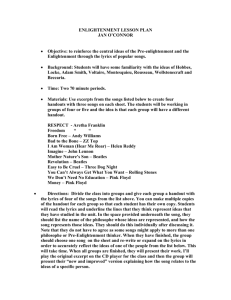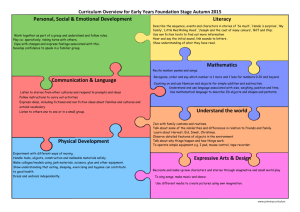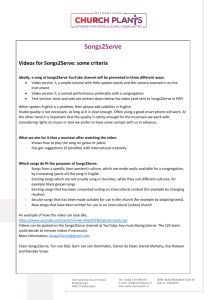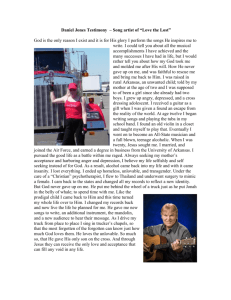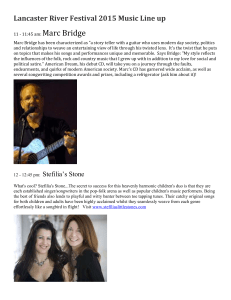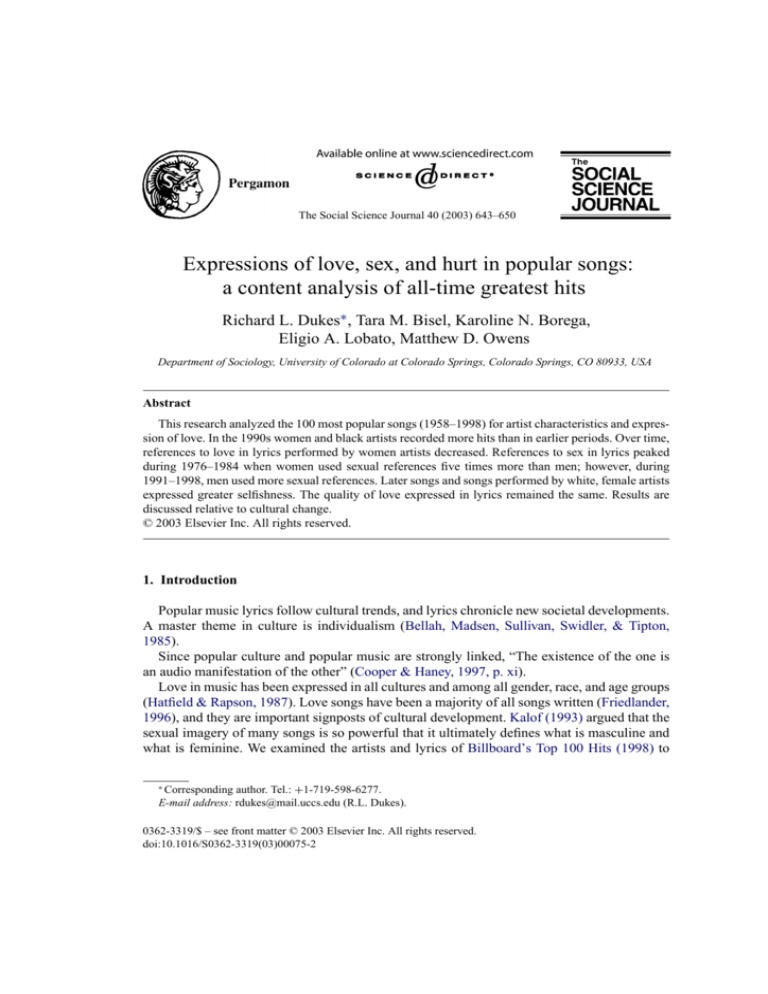
The Social Science Journal 40 (2003) 643–650
Expressions of love, sex, and hurt in popular songs:
a content analysis of all-time greatest hits
Richard L. Dukes∗ , Tara M. Bisel, Karoline N. Borega,
Eligio A. Lobato, Matthew D. Owens
Department of Sociology, University of Colorado at Colorado Springs, Colorado Springs, CO 80933, USA
Abstract
This research analyzed the 100 most popular songs (1958–1998) for artist characteristics and expression of love. In the 1990s women and black artists recorded more hits than in earlier periods. Over time,
references to love in lyrics performed by women artists decreased. References to sex in lyrics peaked
during 1976–1984 when women used sexual references five times more than men; however, during
1991–1998, men used more sexual references. Later songs and songs performed by white, female artists
expressed greater selfishness. The quality of love expressed in lyrics remained the same. Results are
discussed relative to cultural change.
© 2003 Elsevier Inc. All rights reserved.
1. Introduction
Popular music lyrics follow cultural trends, and lyrics chronicle new societal developments.
A master theme in culture is individualism (Bellah, Madsen, Sullivan, Swidler, & Tipton,
1985).
Since popular culture and popular music are strongly linked, “The existence of the one is
an audio manifestation of the other” (Cooper & Haney, 1997, p. xi).
Love in music has been expressed in all cultures and among all gender, race, and age groups
(Hatfield & Rapson, 1987). Love songs have been a majority of all songs written (Friedlander,
1996), and they are important signposts of cultural development. Kalof (1993) argued that the
sexual imagery of many songs is so powerful that it ultimately defines what is masculine and
what is feminine. We examined the artists and lyrics of Billboard’s Top 100 Hits (1998) to
∗
Corresponding author. Tel.: +1-719-598-6277.
E-mail address: rdukes@mail.uccs.edu (R.L. Dukes).
0362-3319/$ – see front matter © 2003 Elsevier Inc. All rights reserved.
doi:10.1016/S0362-3319(03)00075-2
644
R.L. Dukes et al. / The Social Science Journal 40 (2003) 643–650
gauge changes in the expression of love in the culture and inclusiveness of African-American
artists and women in communicating those changes.
The quality of love has been described in Sternberg’s Triangular Theory of love (1988) and
in Peck five characteristics (1978). Sternberg’s components included intimacy, passion and
commitment. Csikzentmihalyi (1980) defined love as the investment “of attention in another
person with the intention of realizing that person’s goals” (1980, p. 313). Peck (1978) called
this aspect of love circularity. Additionally, Peck argued that one grows spiritually through
loving, and one must love oneself to be capable of loving another. Peck also argued that effort
was required and love was a choice, not a condition that was thrust upon the lover. We argue
that the quality of love can be defined by these eight characteristics.
Over time, the expression of love reflected in song lyrics may have changed as the culture
has become more individualistic, the women’s movement has matured, and as the stage of
young adulthood has further delayed entry of young people into the labor market. The results
of these processes have been later age at marriage and partial economic dependence by young
people on their parents, sometimes until age 30 (Allsop, 1999, Chapter 8). We ask how these
changes have affected the expression of love in popular music.
Three additional trends have affected the recording industry. First, large recording companies
have given contracts to a smaller number of more popular artists than in the past. Second,
major record companies have taken fewer chances on recordings. They have required that each
recording is maximally profitable. Third, women and African-Americans have established
themselves as loyal fans who actually buy recordings (Jeffrey, 1998).
1.1. Hypotheses
The following hypotheses were tested: (1) the proportion of women artists in Top 100 songs
has increased, (2) the proportion of African-American artists in Top 100 songs has increased,
(3) lyrics of recent Top 100 love songs have contained fewer references to love, (4) lyrics
of recent Top 100 love songs have contained more references to sex, and (5) lyrics of recent
Top 100 love songs have expressed a more selfish point of view, and (6) the quality of love
expressed in Top 100 love songs has diminished.
2. Method
In 1958, Billboard magazine began a weekly sales chart, Top 40, a list of the current
top-selling songs. In 1998, Billboard celebrated the 40th anniversary of the chart by publishing a list of the all time, top 100 songs 1958–1998. The Top 100 songs were clustered in
three periods. The first cluster of 21 songs dominated the number one ranking between 1958
and 1972. A second cluster of 30 songs topped the charts between 1976 and 1984. A third
cluster of 49 songs qualified for the top 100 songs during 1991–1998.
From the Internet, we downloaded the lyrics for all 100 songs (http://www.lyrics.ch was a
valuable source), and we content analyzed them in an effort to distill the meaning of love as
expressed by the artist/composer. Eighty-one songs had lyrics about love. Inductive coding of
these songs showed that the majority had romantic love as their main theme (Eros, Lee, 1973);
R.L. Dukes et al. / The Social Science Journal 40 (2003) 643–650
645
however, several songs such as Hey Jude (The Beatles, 1968) were written for a loved one
other than one’s partner (Storge, Lee, 1973).
Inductive coding showed that many of the love songs expressed being hurt as a result of
love that had been lost, but, in several of the songs, hurt was not of the traditional kind. One
sweet day (Carey & Boyz II Men, 1995) expressed sadness at the death of a lover, and Alone
again (Naturally) (O’Sullivan, 1972), expressed a feeling of total isolation and abandonment
following the death of a parent.
Inductive coding also showed that many of the expressions of love in the top 100 song lyrics
were crass appeals to sex and passion such as, The bump ’n grind (Kelly, 1994) and Physical
(Newton-John, 1981). To understand the quality of love expressed by a song, we coded lyrics for
presence or absence of Sternberg’s three themes (1988) and Peck’s five characteristics (1978).
Additionally, we used Jeffrey’s (1998) categories of genre to classify each song as country,
rock-and-roll, rhythm and blues, alternative, or rap/hip-hop. Finally, we conducted counts of
words that represented love (e.g., love, care, cherish), sex (e.g., make love, body, lay), and hurt
(e.g., cry, pain, break my heart). Inter-observer reliability was over eighty percent.
3. Results
The percentage of love songs did not change significantly over the three time periods
(1958–1972, 1976–1984, and 1991–1998). The Cramer’s V was .05, and χ2 = .00.
Rock-and-roll and rhythm and blues were the only genres that had songs in the top 100
for each period. We used dummy variable coding for Rock-and-Roll (0,1), Rhythm and Blues
(0,1), and Hip-Hop (0,1). The reference category was called “other,” and it contained Country
and Alternative music. We examined the effects of gender, race, and period on our three
dummy variables for genre. No significant association was found for gender, but a significant
association was found for race (Cramer’s V = .68, χ2 = 45.27, p < .001). Additionally,
we performed analysis of variance and Kruskal–Wallis tests on data. (Kruskal, 1952). Results
duplicated Cramer’s V and χ2 . Analysis of variance results are presented on Table 1.
Table 1
Analysis of variance of characteristics of top 100 songs by gender, race, and period
Dependent variable
Genre
Rock-and-Roll (0,1)
Rhythn and Blues (0,1)
Hip-Hop (0,1)
Passion
Love word index
Sex word index
Selfishness
∗
p < .05.
p < .01.
∗∗
Gender
Race
Period
Man
Woman
Black
White
1
2
3
n.s.
n.s.
n.s.
.47
.16
.08
n.s.
n.s.
n.s.
n.s.
.67∗
.26∗∗
.19∗
n.s.
.26
.47
.28
n.s.
n.s.
n.s.
.28
.83∗∗
.18∗∗
.08
n.s.
n.s.
n.s.
.38∗
.85
n.s.
.00
n.s.
.25
n.s.
n.s.
.83
n.s.
.00
n.s.
.22
n.s.
n.s.
.26∗∗
n.s.
.48
n.s.
.17∗
n.s.
n.s.
646
R.L. Dukes et al. / The Social Science Journal 40 (2003) 643–650
Of the 47 African-American artists who had hits in the top 100, 12 (25%) were rock-and-roll
songs, 22 (47%) were rhythm and blues songs, and 13 (27%) were rap/hip-hop. Conversely,
among the 52 songs in the top 100 that were performed by white artists, 43 (87%) were
rock-and-roll songs. Genre also varied by period (Cramer’s V = .44, χ2 = 38.49, p < .001).
Rock-and-roll and rhythm and blues songs were present in all three time periods. From 1958
to 1972, 85% of the top 100 songs were rock-and-roll. From 1976 to 1984, 83% of the top
100 songs were rock-and-roll, but in the most recent period (1991–1998) of the top 100 songs,
only 26% were rock-and-roll. Of the 49 songs in the current period, the number of rap/hip-hop
songs (n = 17, 35%) has slightly surpassed the number of rock-and-roll songs (n = 16, 33%)
as the leading genre.
We found a relation between genre and whether or not the song was a love song (Cramer’s
V = .32, χ2 = 9.89, p < .05). The rhythm and blues genre contained the highest percentage
of love songs (96%). Eighty-two percent of rock-and-roll songs in the top 100 were love songs,
but only 59% of rap/hip-hop songs were love songs.
Songs became longer from 1958 to 1998. In the first period (1958–1972) the average number
of lines was 31. In the second period, (1976–1984) the average number of lines was 48, and in
the third period (1991–1998) the average number of lines was 55 [F(2, 97) = 4.39; p < .05].
Length of lyrics was not associated with black artists or women artists.
We examined the effect of gender of the artist(s) to see if women had made inroads into
the top 100 songs during the last 40 years. Of the 20 songs from the earliest period, only
3 (15%) were recorded by female artists. In the middle period, 13 of 30 (43%) songs were
performed by women, and in the most recent period, 26 of 49 songs (53%) were performed by
women (Cramer’s V = .29, and χ2 = 8.43). These differences were statistically significant
(p < .05)
Next, we created a category of African-American. It was scored as “1” when any AfricanAmericans were listed as the recording artist(s). In the earliest period, African-Americans
performed 8 of 20 songs (40%). In the middle period African-Americans performed 8 of 30
songs (27%), but in the most recent period African-American artists performed 31 of 49 songs
(63%). The Cramer’s V was .33, and χ2 was 10.56 (p < .01).
We checked for an interaction between gender and race on the percentage of the top 100
songs in each period. Among 17 songs performed by men in the early period, 6 (35%) were
performed by African-Americans. Among 17 songs performed by men in the middle period,
4 (24%) were performed by African-Americans, but among 23 songs performed in the most
recent period, 16 (70%) were performed by African-American artists (Cramer’s V = .41
and χ2 = 9.39, p < .01). A similar pattern was observed for women, but results were not
statistically significant.
3.1. Love words index
We counted the number of sexwords in lyrics, but since the average length of songs became
longer from 1958 to 1998, we constructed an index that divided the number of love words by
the number of lines in the song. This love word index had a mean of .20 love words per line
of lyrics. The median was .10. The standard deviation was .26, and the index ranged from 0
to 1.33 love words per line. The first time ever I saw your face (Flack, 1972) had 1.33 love
R.L. Dukes et al. / The Social Science Journal 40 (2003) 643–650
647
words per line. Analysis of variance showed significant effects for gender and period on the
love word index, but a statistically significant effect for race was not observed. The mean score
for men was .16 love words per line, and the mean for women was .26. This difference was
statistically significant [F(1, 98) = 11.84; p < .01].
Over time, lyrics contained fewer love words. From 1958 to 1972, the average was .25 love
words per line. From 1976 to 1984, the average was .22, and from 1991 to 1998 the average was
.17. These differences were statistically significant [F(2, 98) = 4.87, p < .05; see Table 1].
A statistically significant effect of period was not observed using the Kruskal–Wallis test
(Kruskal, 1952). This effect was the only main effect for which Kruskal–Wallis test did not
duplicate results of the analysis of variance.
Using analysis of variance, an interaction was observed between period and gender
[F(2, 98) = 5.90; p < .01; not shown on Table 1]. The average number of love words in
lyrics performed by female artists dropped throughout the three periods. The average was .74
in 1958–1972, and it was .29 in 1976–1984. From 1991 to 1998, it was .19 During this time,
the love word index for lyrics performed by men ranged from .15 to .17 (not significant)
3.2. Sex words index
The mean number of sex words was 5.61. The median was 0, and the range was 0–46. We
created a sex word index that controlled for the length of the lyrics. The sex word index had a
mean of .13, and the median was 0. The standard deviation was .28, and the range was 2.11.
Four songs contained more than .67 sex word per line of lyrics. These songs were, Physical
(Newton-John, 1981), Bette Davis eyes (Carnes, 1981), Hot stuff (Summer, 1979a), and Bad
girls (Summer, 1979b).
Using analysis of variance, we investigated the effects of gender, race and period on the
sex word index. Men used an average of .08 sex words per line of lyrics, and women used
twice as many, .19 sex words per line. This difference was statistically significant [F(1, 98) =
6.25; p < .05]. The sex word index peaked in the middle period (.06 in 1958–1972, .19 in
1976–1984, and .12 in 1991–1998). While the rate tripled from the first time period to the
second, the differences among the means were not statistically significant, perhaps due to the
small sample size.
A statistical interaction was observed between gender and period [F(2, 98) = 3.47; p < .05;
not shown on Table 1]. This interaction revealed that men steadily increased their use of sex
words (.02 in 1958–1972, .07 in 1976–1980, and .14 in 1991–1998). However, women artists
used far fewer sex words in their most recent songs (.31 in 1958–1972, .35 in 1976–1984, and
.09 in 1991–1998).
3.3. Hurt words index
We coded the number of hurt words in each love song. The mean number of these words
was 5.13, and the median was 1.00. The standard deviation was 9.01, and the range was 0–44
words. We created a hurt word index by dividing the number of hurt words by the number of
lines of lyrics. The mean of this index was .12 hurt words per line, and the median was .02.
The standard deviation was .19, and the range was 0–.94. Three songs had index values of at
648
R.L. Dukes et al. / The Social Science Journal 40 (2003) 643–650
least .75 hurt word per line. These songs included Stay (I missed you) by Loeb & Nine Stories
(1994), Unbreak my heart (Braxton, 1996), When doves cry (Prince, 1984).
We used analysis of variance to predict the hurt word index from gender, race, and period.
None of the main effects and none of the interactions were statistically significant (not shown
on Table 1).
3.4. Selfishness
We coded the lyrics into two categories of selfishness: love on your terms or love on our
terms (coded 0), and love on my terms (coded 1). We analyzed selfishness by variables of
gender, race, and period. The proportion of lyrics that were selfish increased over time (.25 in
1958–1972; .33 in 1976–1984, and .37 in 1991–1998), but the differences were not statistically
significant. Thirty-three percent of songs performed by man and 33% of songs performed by
women showed selfishness (not significant).
Lyrics performed by black artists were selfish in 28% of the songs, and lyrics performed
by white artists were selfish in 38% of the songs. This difference was statistically significant
[F(1, 98) = 4.26; p < .05; see Table 1]. Furthermore, the dummy variables of black and
woman interacted statistically [F(1, 98) = 4.02; p < .05; not shown on Table 1]. The lowest
selfishness score was obtained for black women (19%), and the highest selfishness score was
obtained for white women (48%).
3.5. Quality of love
We measured the quality of love by counting the number of characteristics from Sternberg
(1988) and Peck (1978). The overall mean was 2.78 characteristics, and the median was 2.00.
The standard deviation was 1.54, and the range was 0–8. Only one song, Endless Love (Ross
& Riche, 1981) earned a maximum score of 8. None of the main effects and none of the
interactions were statistically significant so they were not shown on Table 1.
4. Discussion
If record companies were responding to lower sales volume by concentrating on fewer artists
and better material, this mechanism would explain the greater number of top 100 songs from
1991 to 1998 (41).
Women and African-American artists increasingly were represented in the top 100 songs.
Furthermore, black men consistently made the greatest inroads into the top 100, and white
men lost the most ground. Currently, rap/hip-hop is the strongest genre, and its development is
recent (1991–1998). Apparently, sales have contributed to greater inclusiveness, since a high
percentage of consumers of rap/hip-hop actually buy the recordings. Hypotheses one and two
were supported.
Lyrics performed by women contained more love words than lyrics performed by men.
Early women artists may have been expressing a theme of finding a mate at a young age,
but recently both men and women have been starting careers and families later, and artists of
R.L. Dukes et al. / The Social Science Journal 40 (2003) 643–650
649
both genders have become more circumspect about permanent relations. Hypothesis three was
supported.
The greatest average number of sex words was used by black men (1991–1998), a time
when songs had become longer; however, the most concentrated doses of sex words (measured
by the sex word index) were delivered by women in the middle period. Perhaps this finding is
linked to sexual liberation of the 1960s and 1970s; however, with liberation has came greater
financial responsibility of women. Additionally, the trends in music may be a response to
teenage pregnancy, single parenthood, abuse and sexually transmitted diseases. It is reasonable
to assume that overall, songwriters have become more cautious about blatant appeals to sex in
song lyrics. Hypothesis four was supported.
We expected that selfishness reflected in song lyrics had increased over the last forty years
(Hypothesis 5). Our results did not support this notion. While the culture is characterized by
more individuality (Bellah et al., 1985), record buyers have become older, and these more
mature consumers may expect greater give-and-take in love relations. We hypothesized that
greater selfishness would be triggered by cohort differences; however, the data suggested that
greater selfishness could have been triggered by differential power. Results showed that lyrics
performed by white artists expressed a greater percentage of appeals to selfishness than lyrics
performed by African-American artists. Perhaps African-Americans may have fewer romantic
opportunities with partners of other races because of continuing racial discrimination. Using
exchange theory, greater power by whites in the market for love may have resulted in a greater
expression of selfishness in song lyrics (Blau, 1986).
Finally, the quality of love expressed in song lyrics did not vary by period, gender, or race.
Hypothesis six was not supported. Only one song reached the maximum quality level, and the
average lyrics remained only a partial expression of complete love.
References
Allsop, R. J. (Ed.). (1999). The Wall Street Journal almanac. New York: Ballantine
Beatles, The (1968). Hey Jude. London: Apple.
Bellah, R. N., Madsen, R., Sullivan, W. M., Swidler, A., & Tipton, S. M. (1985). Habits of the heart: Individualism
in American life. New York: Harper and Row.
Billboard (1998). The hot 100 of the hot 100: Top songs of four decades. Retrieved on 8-4-98.
Http://www.billboard.com/sr/hot100/bigchart.html.
Blau, P. (1986) Exchange and power in social life (Rev. ed.). New York: Wiley.
Braxton, T. (1996). Unbreak my heart. New York: LaFace/Arista.
Carey, M., & Boyz II Men. (1995). One sweet day. Hollywood, CA: Columbia.
Carnes, K. (1981). Bette Davis eyes. Hollywood, CA: EMI America.
Cooper, B., & Haney, W. S. (1997). Rock music in American popular culture: More rock-and-roll resources. Bowling
Green, OH: Bowling Green State University Popular Press.
Csikzentmihalyi, M. (1980) Love and the dynamics of personal growth. In K. S. Pope & Associates (Eds.) On love
and loving (pp. 306–326). San Francisco, CA: Jossey-Bass.
Flack R. (1972). The first time ever I saw your face. New York: Atlantic.
Friedlander, P. (1996). Rock-and-roll: A social history. Boulder, CO: Westview Press.
Hatfield, E., & Rapson, R. (1987). Passionate love: New directions in research. In W. H. Jones & D. Perlman (Eds.),
Advances in personal relationships (Vol. 1, pp. 109–139). Greenwich, CT: JAI Press.
Jeffrey, D. (1998). Country is no. 1 genre, but its fans aren’t biggest buyers. Billboard, 110(36), 103.
650
R.L. Dukes et al. / The Social Science Journal 40 (2003) 643–650
Kalof, L. (1993). Dilemmas of femininity. The Sociological Quarterly, 34, 639–651.
Kelly, R. (1994). The bump n grind. Chicago, IL: Jive
Kruskal, W. H. (1952). A nonparametric test for the several sample problem. Annals of Mathematical Statistics, 23,
525–540.
Lee, J. A. (1973) The colors of love: An exploration of the ways of loving. Don Mills, Ontario: New Press.
Loeb, L., & Nine Stories (1994). Stay (I missed you). New York: RCA.
Newton-John, O. (1981). Physical. Los Angeles, CA: MCA.
O’Sullivan, G. (1972). Alone again (Naturally). London, U. K.: MAM
Peck, M. S. (1978). The road less traveled: A new psychology of love, traditional values, and spiritual growth.
New York: Simon and Schuster.
Prince. (1984). When doves cry. Burbank, CA: Warner Brothers.
Ross, D., & Riche, L. (1981). Endless love. Hollywood, CA: Motown.
Sternberg, R. J. (1988) Triangulating love. In R. J. Sternberg & M. L. Barnes (Eds.) The psychology of love
(pp. 119–138). New York: Yale University Press.
Summer, D. (1979a) Hot stuff. New York: Casablanca.
Summer, D. (1979b). Bad girls New York: Casablanca.



